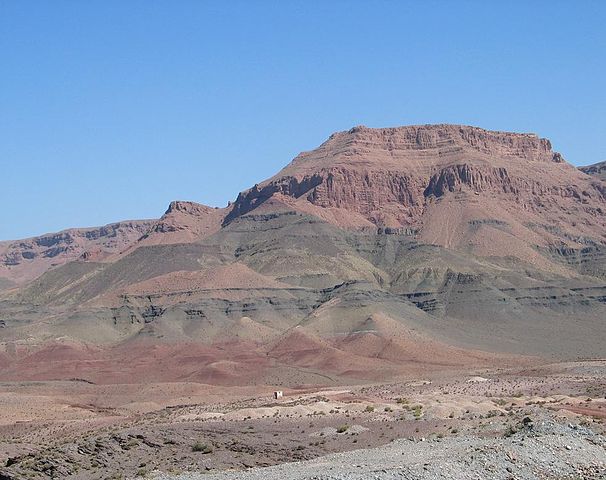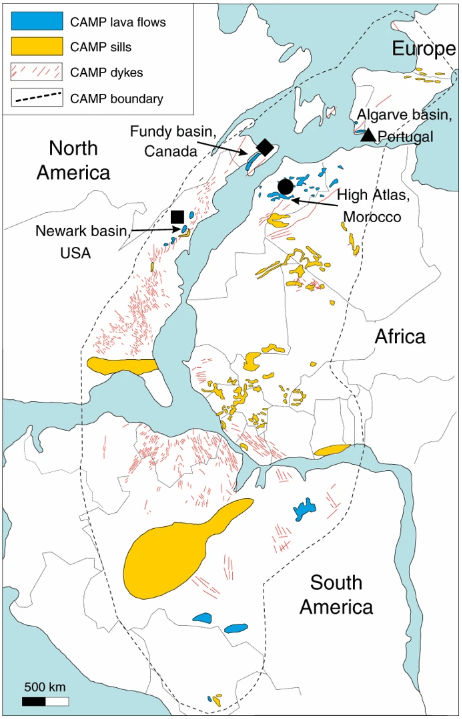200 million years ago, a mass termination event wiped out about 76%of all types on Earth– both terrestrial and marine.
A new paper shows that pulses of volcanic eruptions were responsible, which those pulses launched the same amount of CO 2 as humans are releasing today.
Researchers have actually been pursuing years to understand what could have triggered the J-T extinction occasion. The theoretical causes consist of an asteroid or comet effect, gradual modifications in the Earth’s cycles and processes, and volcanic eruptions. The J-T extinction is one of five mass extinctions in Earth’s history, and the clinical dispute about the causes is fascinating.
While there’s some evidence to support each of those causes, the case for volcanic eruptions is becoming clearer. In a new paper, a team of scientists points the finger at huge volcanic eruptions in what is now the Atlantic Ocean.
“CAMP eruptions were rapid and potentially disastrous for both environment and biosphere.”
Capriolo et al, 2020
The paper is titled “Deep CO 2 in the end-Triassic Central Atlantic Magmatic Province.” The lead author is Manfredo Capriolo from the University of Padolo, in Italy. The paper is released in the journal Nature Communications.
The authors focused on what are called Large Igneous Provinces, or LIPs.
Image Credit: By Williamborg– Own work, CC BY-SA 3.0, https://commons.wikimedia.org/w/index.php?curid=26290915
At the time of the J-T extinction, Earth’s land mass was one big continent called Pangaea.



Volcanic eruptions from Large Igneous Provinces coincide with mass terminations during the Phanerozoic age. The Phanerozoic age started about 540 million years ago, and is the present period. It’s the age during which there is plentiful life on Earth.
Due to the fact that eruptions correspond with terminations, it recommends a cause-effect relationship.
The authors took a look at over 200 samples of basaltic lava circulations and sills in the CAMP. There are a host of chemicals launched throughout eruptions that can wreak havoc on the environment and climate. They include CO, CO 2, CH 4, SO 2, H 2 S, HCl, and CH 3 Cl. The group of researchers were mainly concerned with CO 2



Their outcomes recommend that the CAMP produced up to 100,000 gigatons of CO 2 which part of that came from the middle-lower crust and mantle. The origins of that carbon dioxide are essential, since it recommends that the eruptions were extremely rapid, and devastating. The scientists state that the eruptions resembled noticable “pulses” of CO 2 Because those pulses were so quick, they overwhelmed the Earth’s capability to re-absorb it. “CAMP eruptions were fast and possibly catastrophic for both environment and biosphere.”
The pulsing nature of these eruptions made them specifically harmful. The pulses were triggered by bubbles of CO 2 and elemental carbon in Earth’s “transcrustal magmatic pipes system” according to the paper.
The lava was saturated with CO 2 and “can discuss the pulsed eruptive design of CAMP, where CO 2 serves as propellant for magma climb, causing fast and violent eruptive pulses.” The authors point to the nature of some modern-day eruptions in Hawaii, where high concentrations of CO 2 in the basalt triggered magma to rise over 5 km to the surface area, and to imitate water fountains when it emerged.
In the conclusion of the paper the authors mention that the quantity of CO 2 produced in these eruptions is approximately equal to the quantity of CO 2 launched into the atmosphere by humans in the 21 st century. Even a single pulse may have done so.
” In truth, a single temporary CAMP magmatic pulse … may release about 5?1016?
So there we have it. We’re handling to launch as much CO 2 as a single, enormous volcanic pulse did hundreds of millions of years back.
Individuals who don’t believe the science behind human-caused climate change typically point to volcanoes as the genuine offenders. And while some of it gets away into the atmosphere from volcanoes, volcanic emissions of CO 2 in our age are tiny compared to human emissions.
Eruptions in Iceland and elsewhere can cut airline company traffic for a while, and they appear outstanding. But modern day eruptions do not come close to those at the time of the J-T termination.
It’s our emissions that are driving international climate modification, and as extensive science like this research study reveals us, the consequences can be alarming.
More:
- Research Paper: Deep CO 2 in the end-Triassic Central Atlantic Magmatic Province
- Wikipedia: Triassic– Jurassic extinction occasion
- Universe Today: A Fast Rise in Temperature Level Led to the Worst Termination in our Planet’s History

